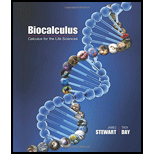
Biocalculus
15th Edition
ISBN: 9781133109631
Author: Stewart, JAMES, Day, Troy
Publisher: Cengage Learning,
expand_more
expand_more
format_list_bulleted
Question
Chapter 9, Problem 17E
(a)
To determine
To calculate: the value of
(b)
To determine
Whether increase in water temperature will improve or worsen the chance of escape of tadpole’s.
(c)
To determine
Whether increase in size of tadpoles’ will improve or worsen the chance of escape of tadpole’s.
Expert Solution & Answer
Trending nowThis is a popular solution!

Students have asked these similar questions
(2) (22 points) Let F(x, y, z) = (x sin y, cos y, ―xy).
(a) (2 points) Calculate V. F.
(b) (6 points) Given a vector field
is everywhere defined with V
G₁(x, y, z) = *
G2(x, y, z) = −
G3(x, y, z) = 0.
0
0
F(x, y, z) = (F₁(x, y, z), F₂(x, y, z), F(x, y, z)) that
F = 0, let G = (G1, G2, G3) where
F₂(x,
y,
y, t) dt
- √ F³(x, t, 0) dt,
*
F1(x,
y, t) dt,
t) dt - √ F
Calculate G for the vector field F(x, y, z) = (x sin y, cos y, -xy).
Evaluate the following integral over the Region R.
(Answer accurate to 2 decimal places).
√ √(x + y) A
R
R = {(x, y) | 25 < x² + y² ≤ 36, x < 0}
Hint: The integral and Region is defined in rectangular coordinates.
Find the volume of the solid that lies under the paraboloid z = 81 - x² - y² and within the cylinder
(x − 1)² + y² = 1. A plot of an example of a similar solid is shown below. (Answer accurate to 2
decimal places).
Volume using Double Integral
Paraboloid & Cylinder
-3
Hint: The integral and region is defined in polar coordinates.
Knowledge Booster
Learn more about
Need a deep-dive on the concept behind this application? Look no further. Learn more about this topic, calculus and related others by exploring similar questions and additional content below.Similar questions
- Evaluate the following integral over the Region R. (Answer accurate to 2 decimal places). √4(1–2² 4(1 - x² - y²) dA R 3 R = {(r,0) | 0 ≤ r≤ 2,0π ≤0≤¼˜}. Hint: The integral is defined in rectangular coordinates. The Region is defined in polar coordinates.arrow_forwardEvaluate the following integral over the Region R. (Answer accurate to 2 decimal places). R - 1 · {(r,0) | 1 ≤ r≤ 5,½π≤ 0<1π}. Hint: Be sure to convert to Polar coordinates. Use the correct differential for Polar Coordinates.arrow_forwardEvaluate the following integral over the Region R. (Answer accurate to 2 decimal places). √ √2(x+y) dA R R = {(x, y) | 4 < x² + y² < 25,0 < x} Hint: The integral and Region is defined in rectangular coordinates.arrow_forward
- HW: The frame shown in the figure is pinned at A and C. Use moment distribution method, with and without modifications, to draw NFD, SFD, and BMD. B I I 40 kN/m A 3 m 4 marrow_forwardLet the region R be the area enclosed by the function f(x)= = 3x² and g(x) = 4x. If the region R is the base of a solid such that each cross section perpendicular to the x-axis is an isosceles right triangle with a leg in the region R, find the volume of the solid. You may use a calculator and round to the nearest thousandth. y 11 10 9 00 8 7 9 5 4 3 2 1 -1 -1 x 1 2arrow_forwardLet the region R be the area enclosed by the function f(x) = ex — 1, the horizontal line y = -4 and the vertical lines x = 0 and x = 3. Find the volume of the solid generated when the region R is revolved about the line y = -4. You may use a calculator and round to the nearest thousandth. 20 15 10 5 y I I I | I + -1.5 -1 -0.5 0.5 1 1.5 2 2.5 3 -5 I -10 -15 I + I I T I I + -20 I + -25 I I I -30 I 3.5 4 xarrow_forward
arrow_back_ios
SEE MORE QUESTIONS
arrow_forward_ios
Recommended textbooks for you
- Algebra & Trigonometry with Analytic GeometryAlgebraISBN:9781133382119Author:SwokowskiPublisher:Cengage
 Functions and Change: A Modeling Approach to Coll...AlgebraISBN:9781337111348Author:Bruce Crauder, Benny Evans, Alan NoellPublisher:Cengage Learning
Functions and Change: A Modeling Approach to Coll...AlgebraISBN:9781337111348Author:Bruce Crauder, Benny Evans, Alan NoellPublisher:Cengage Learning


Algebra & Trigonometry with Analytic Geometry
Algebra
ISBN:9781133382119
Author:Swokowski
Publisher:Cengage

Functions and Change: A Modeling Approach to Coll...
Algebra
ISBN:9781337111348
Author:Bruce Crauder, Benny Evans, Alan Noell
Publisher:Cengage Learning


Derivatives of Trigonometric Functions - Product Rule Quotient & Chain Rule - Calculus Tutorial; Author: The Organic Chemistry Tutor;https://www.youtube.com/watch?v=_niP0JaOgHY;License: Standard YouTube License, CC-BY